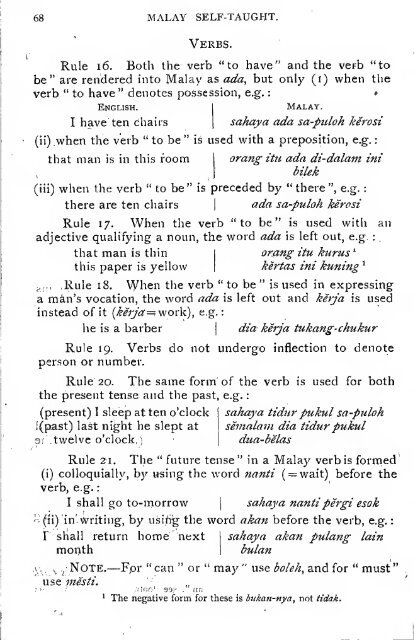Malay self-taught by the natural method : with ... - Sabrizain.org
Malay self-taught by the natural method : with ... - Sabrizain.org
Malay self-taught by the natural method : with ... - Sabrizain.org
You also want an ePaper? Increase the reach of your titles
YUMPU automatically turns print PDFs into web optimized ePapers that Google loves.
68 malay <strong>self</strong>-<strong>taught</strong>.<br />
Verbs.<br />
Rule i6. Both <strong>the</strong> verb "to have" and <strong>the</strong> verb "to<br />
be" are rendered into <strong>Malay</strong> as ada, but only (r) when <strong>the</strong><br />
verb " to have" denotes possession, e.g.<br />
»<br />
English.<br />
<strong>Malay</strong>.<br />
I have ten chairs<br />
sahaya ada sa-puloh kerosi<br />
(ii) when <strong>the</strong> verb " to be " is used <strong>with</strong> a preposition, e.g.<br />
that man is in this room<br />
:<br />
: .<br />
orang iUi ada di-dalam ini<br />
bilek<br />
(iii) when <strong>the</strong> verb " to be " is preceded <strong>by</strong> " <strong>the</strong>re ", e.g. :<br />
<strong>the</strong>re are ten chairs |<br />
ada<br />
sa-puloh kerosi<br />
Rule 17. When <strong>the</strong> verb "to be" is used <strong>with</strong> an<br />
adjective qualifying a noun, <strong>the</strong> word ada is left out, e.g :<br />
I<br />
|<br />
that man is thin<br />
this paper is yellow<br />
OKang<br />
kertas<br />
itu ku7^us "<br />
ini kuning^<br />
J,,,, Rule 1 8. \Vhen <strong>the</strong> verb " to be " is used in expressing<br />
a man's vocation, <strong>the</strong> word ada is left out and kerja is used<br />
instead of it {kerja =^0^:^), e.g.:<br />
he is a barber |<br />
dia<br />
kerja tukang-chukur<br />
Rule 19. Verbs do not undergo inflection to denote<br />
person or number.<br />
Rule 20. The same form' of <strong>the</strong> verb is used for both<br />
<strong>the</strong> present tense and <strong>the</strong> past, e.g.<br />
(present) I sleep at ten o'clock<br />
l(past) last night he slept at<br />
3; '.twelve o'clock,)<br />
:<br />
sahaya tidur pukul sa-puloh<br />
semalam dia tidur pukul<br />
dua-belas<br />
Rule 21. The " future tense" in a <strong>Malay</strong> verbis forrned<br />
(i) colloquially, b)' using <strong>the</strong> word nanti ( = wait) before <strong>the</strong><br />
verb, e.g.<br />
:<br />
I shall go to-morrow |<br />
sahaya<br />
nanti pergi esok<br />
'-•(ii) in- Writing, <strong>by</strong> usirtg <strong>the</strong> word akan before <strong>the</strong> verb, e.g.<br />
y, ,<br />
r shall return home next<br />
month<br />
Y<br />
sahaya akan pulang lain<br />
./Note.—Fpr "can " or " may " use boleh, and for " must"<br />
use mesti.<br />
' The negative form for <strong>the</strong>se is bukan-nya, not Hdak.<br />
:

















